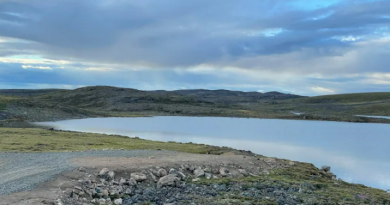New study finds Alaska wetlands shrinking

A team of geoscientists based out of Texas have added to the growing number of studies pointing to a warming Arctic climate. Using newly available remote-sensing technology, scientists at the Southwest Research Institute found the Ahnewetut Wetlands in Kobuk Valley National Park, located in southwestern Alaska, have experienced an accelerated loss of surface water over the past 30 years.
The researchers compared features known as thaw lakes and ponds, which are bodies of freshwater, usually shallow, which form in depressions due to melting permafrost. It’s how most Arctic lakes are formed; hundreds of small thaw lakes and ponds stretch across the park’s lowland areas, according to the National Park Service.
The Kobuk Valley is littered with the small collections of water — tens of thousands of shallow lakes are distributed across the Arctic as a whole — but over the past two consecutive 27-year periods they’ve been shrinking faster, according to the institute’s findings. Those periods coincide with a well-known cooling and warming cycle called the Pacific Decadal Oscillation, a period of about five decades.
The geoscientists’ analysis compared old, aerial photos with new satellite imagery to measure the changes of 22 shallow lakes and surrounding permafrost in the park between 1951 and 2005, Science Daily reported.
Total water-body surface area insubstantially decreased during the previous period, losing only 0.4 percent. But during the most recent period, it had decreased by 5.5 percent, Dr. Marius Necsoiu, principal investigator for the study, told Science Daily.
The surface level of the lakes and ponds in the park were stable during the previous period, Necsoiu said, which experienced cooler temperatures. The most recent 27-year timespan saw warmer temperatures, resulting in the complete drainage of two ponds.
Kobuk Valley’s wetlands aren’t the only area in Alaska where the lakes are shrinking. In 2007, Arctic Network (ARCN) began its own shallow lake monitoring project. The network installed monitoring sites at the Bering Land Bridge National Preserve, as well as Kobuk Valley National Park. It monitors the areas’ “vital signs,” like water chemistry and vegetation composition, and collects aerial photographs and satellite images.
At that time, researchers concluded lake surface area in the park had declined by 14-20 percent. They identified 12 lakes in the park that drained “catastrophically” during the past 10 years. Those findings caught the attention of park staff, who began an in-depth investigation in 2010. A total of 20 drained lakes were surveyed, and findings indicated the lakes shrunk as a result of a decrease in the thickness of frozen soils.
Central Alaska Network, another park monitoring network, conducted their own photo comparison of shallow lakes at two sites in the northwest corner of Denali National Park and Reserve. Although change in the Minchumina basin lowlands was minimal, change in the reserve’s Eolian lowlands was dramatic, researchers concluded. In 27 years, 26 percent of the lakes there had shrunk markedly; another 19 percent were no longer lakes, but had turned into wet meadows.
The decrease of permafrost is affecting more than the shallow lakes, according to a study led by an American Museum of Natural History scientist. The study concludes tree and shrub cover in the far north, including woody shrubs in Alaska, will spread faster than previously expected.
Kobuk Valley is a unique landscape, even for Alaska. It includes a 25-mile stretch of sand dunes, referred to as the Great Kobuk Sand Dunes. The grinding action of ancient glaciers created the dunes, carried to the valley by wind and water. Nearly half a million caribou migrate through the park twice a year, crisscrossing over the dunes.
Contact Jerzy Shedlock at jerzy(at)alaskadispatch.com



